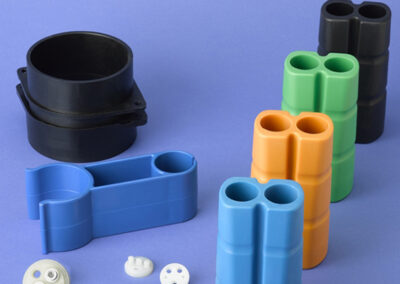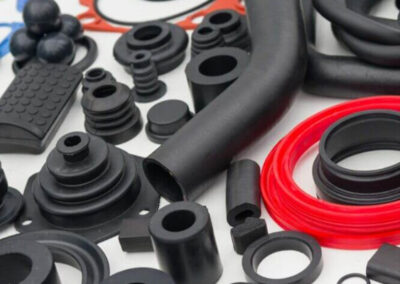Thermoplastics VS Thermosets
The Key Distinction Between Thermoplastics and Thermosets
The fundamental contrast between thermoplastics and thermosets lies in their response to heat.
Thermoplastics
Thermoplastics exhibit low melting points, and when subjected to heat, they become pliable or transition into a liquid state. This characteristic enables them to be molded into a wide range of shapes and designs. Importantly, even when subjected to extreme heat, the chemical composition of the material remains unchanged. Consequently, even after shaping and solidifying, thermoplastics can be reheated, melted, or reshaped without altering their inherent nature.
Think of a thermoplastic material as analogous to water. Water can exist in both liquid and solid states, like ice. Regardless of how many times its physical state changes, its chemical composition remains consistent, and it remains water.
Thermosets
In contrast, thermosets possess high melting points. Once exposed to a specific temperature and solidified, their constituents and physical properties become permanently fixed. They cannot be reverted to their original state by melting and reheating. Instead, when heated further, thermosets will simply combust or char.
Consider thermosets in a similar manner to cookie dough. Once the ingredients are combined and subjected to heat, the end product is the baked cookie. It is impossible to revert it to dough by reheating the material.
Advantages of Thermoplastics
Thermoplastics offer a wide array of benefits, making them highly versatile and environmentally friendly materials for various applications. Here are some key advantages of thermoplastics, each of which contributes to their widespread usage:
-
- Recyclability:
Thermoplastics can be recycled, which significantly reduces their environmental impact. This recyclability helps in the conservation of resources and minimizes waste in landfills. - Corrosion Resistance:
Thermoplastics generally exhibit excellent resistance to corrosion, making them suitable for use in harsh environments and outdoor applications where exposure to moisture and chemicals is a concern. - Impact Resistance:
They are known for their toughness and ability to withstand impact, which is crucial for products that need to endure mechanical stress or potential mishandling. - Chemical Resistance:
Many thermoplastics are highly resistant to a wide range of chemicals, making them ideal for use in chemical processing, pharmaceuticals, and other industries where contact with corrosive substances is common. - Food-Safe:
Several types of thermoplastics are food-safe, meeting strict regulatory standards for use in food packaging and storage applications, ensuring the safety of consumable products. - Customizability:
Thermoplastics are highly customizable materials. They can be enhanced with various coatings, including anti-static and anti-microbial finishes, as well as textured or painted to meet specific aesthetic and functional requirements. - Remolding and Reshaping:
One of their standout features is the ability to be remolded and reshaped when exposed to heat. This characteristic allows for design modifications and adjustments, reducing material wastage. - Blending Possibilities:
Thermoplastics can be blended with other materials such as rubber or fillers to enhance their strength, flexibility, or other desirable properties, making them adaptable to a wide range of applications. - Forming Techniques:
They can be shaped through various manufacturing techniques, including thermoforming and plastic injection molding, providing flexibility in production processes and enabling the creation of intricate and complex designs.
- Recyclability:
Thermoplastics have many advantages that make them more versatile than thermosets. Their recyclability, customizability, reshapeability, versatile molding technology, and more make them an environmentally friendly and versatile choice for a variety of industries and applications.
Types of Thermoplastic Materials
Thermoplastics and thermosets are both widely used in various industries, but thermoplastics are typically more recognizable due to their distinct properties.
-
- Polyvinyl Chloride (PVC)
- Acrylic
- Polypropylene(pp)
- Polycarbonate(PC)
- Polyethylene(PE)
- Nylon(PA)
Thermoplastics are versatile materials that find applications in an array of everyday items, ranging from commonplace objects to sophisticated products. They can be molded and reshaped easily when exposed to heat, making them suitable for an extensive range of applications. For example, you’ll encounter thermoplastics in the form of milk jugs, food packaging, toys, car dashboards, and even bathtubs.
Their ability to be molded into diverse shapes while retaining their core properties makes them indispensable in manufacturing and design.
Advantages of Thermosets
Thermoset materials have unique qualities that make them valuable in a variety of applications, especially where excellent durability and high temperature resistance are required.Here are some of the main advantages of thermoset materials:
-
- Exceptional Hardness and Rigidity:
Thermoset materials are renowned for their hardness and rigidity. They maintain their structural integrity even under significant stress and load-bearing conditions, making them suitable for applications where robustness is critical. - High Stability:
These materials exhibit high dimensional stability, meaning they maintain their shape and size even when exposed to varying environmental conditions, including temperature fluctuations and humidity changes. - High-Temperature Resistance:
One of the standout features of thermoset materials is their exceptional resistance to high temperatures. They can withstand elevated temperatures without softening or deforming, making them ideal for applications where heat resistance is essential. - Reinforcement Capability:
Thermoset materials can be reinforced with materials like Kevlar, carbon fibers, or fiberglass. This reinforcement enhances their strength and adds specific properties like increased tensile strength and impact resistance, expanding their application range. - Longevity:
Due to their heat resistance and structural integrity, thermoset materials have an extended lifespan. They remain stable and unaltered over time, reducing the need for frequent replacements and maintenance.
- Exceptional Hardness and Rigidity:
While thermoset materials offer these remarkable advantages, it’s worth noting that their chemical composition prevents them from being recycled through traditional means. Once they undergo the curing process and solidify, they cannot be melted or reshaped.
Types of Thermoset Materials
In contrast, thermosets possess distinct characteristics that set them apart.
-
- Silicone
- Polyester
- Epoxy
- Melamine
- Urea formaldehyde
- Polyurethane(PU)
Once thermoset materials are exposed to specific temperatures and undergo curing processes, they solidify and take on fixed shapes and properties. Thermosets are highly valuable in applications where durability, strength, and stability are paramount. They are used to create robust protective coatings, resilient fibers, and items such as durable dinnerware.
Unlike thermoplastics, thermosets cannot be melted or reshaped after curing; instead, they maintain their integrity under various conditions, including high temperatures and exposure to chemicals.
Custom Plastic Parts Services–Sungplastic
According to the previous introduction, we understand that thermoplastic and thermoset plastic products are widely present in daily life, and their respective advantages and versatility enable them to meet the needs of a variety of different industries. Sungplastic is a professional plastic parts manufacturing company, we provide a variety of services, including thermoforming and injection molding, to meet your personalized needs. We are committed to providing tailor-made solutions for your plastic parts or products. From mold design to material selection (whether thermoplastic or thermoset) to assembly and packaging, we offer a full range of services to ensure the final part or product produced meets your expectations. Please don’t hesitate to contact us now and let us provide you with an accurate quote.
Get a free quote and design analysis today.
We’ll reply to you within 6 working hours.
We respect your privacy.
+86 139 2927 4777 (WhatsApp, Wechat)


